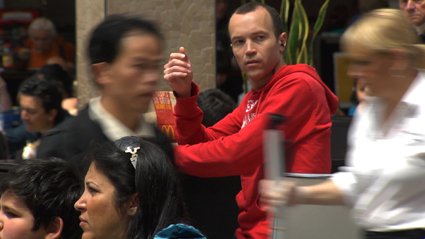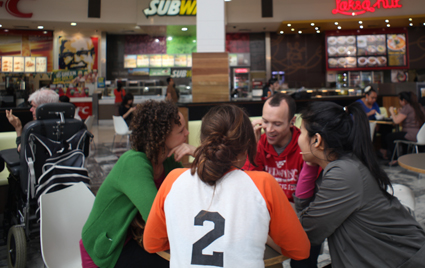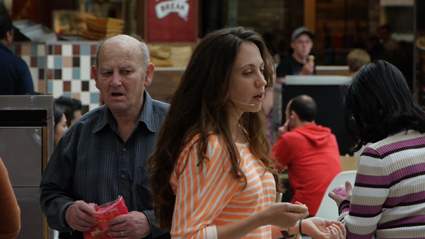Everyday listening performatively large
Urszula Dawkins: Tamara Saulwick: PUBLIC

Tom Davies, PUBLIC
video still Tamara Saulwick;
Tom Davies, PUBLIC
I’m sitting, uncertain to begin with, wearing headphones; listening to fragments of conversations with no definite source. It takes a while—quite a while—to figure out who’s where; and often—usually—I can only locate one performer at a time. The other three are elusive, hidden amid the packed food court at Highpoint Shopping Centre in Melbourne’s inner west. It’s a Saturday afternoon before Christmas: the tiled hall overflows with fidgety kids, tired adults, stacks of shopping bags and pre-made food packs. The headphones mute the reverberating sound cloud of voices that floats between the punters and the atrium ceiling.
Over time, I relax into a humming, lulling soundscape, punctuated by random narratives and stray sentences: “Everybody’s checking each other out,” a voice says. But who, where? I just see shoppers forking up plates of stir-fry, playing with straws and phones. And then: a guy in a red t-shirt, moving reeeal slowly with a Macca’s bag and a Coke. He sits down nearby, his gestures continuing in exaggerated slow motion. The sounds of the paper bag, the crisp ‘tsss’ of snapped-open can are up-close in my ears. I can’t tell what’s ‘live’ or what’s recorded and performed in synch with the soundscape. There’s a disjunct, or perhaps an overlap, or even both: a jarring between what’s ‘out there’—the character, his movements, sounds—and what’s ‘in my head,’ pushed in there via the soundscape.
As PUBLIC unfolds, a second performer appears, strolling through the crowd—her headset mic is the giveaway. She talks about girls getting engaged; a guy on a late shift. The dance track “I Feel Love” is beating in my ears, anthemic and heady.
Another voiceover begins a meandering tale about an online encounter with a ‘chatbot.’ “You can meet him in a public room or you can tap someone and meet in a private room,” says the voice. Am I present here, or am I ‘lurking?’ Am I in a public or a private space; participant or voyeur?

Rachael Dyson-McGregor, Nicola Gunn, Tom Davies, Diana Nguyen, PUBLIC
photo Tamara Kirby
Rachael Dyson-McGregor, Nicola Gunn, Tom Davies, Diana Nguyen, PUBLIC
PUBLIC extends Tamara Saulwick’s interest in ordinary speech and stories—as in Pindrop (see RT111) or her work in development, Endings. In PUBLIC, the scripted, performed text is just one element in the complex interplay of performer, ‘source’ and site. Whereas in Pindrop the stories themselves took thematic precedence, here the interest seems to lie as much, or more, in the shifting and often confounding merger between what’s staged and what’s already present in the space. Throughout PUBLIC I’m increasingly seduced by the way Saulwick, with sound designer Luke Smiles, elevates the rhythms of banal exchange to the level of music or poetry. I listen for the shifting timbres; the voices are melodic lines over an orchestral backing of eye- and ear-scapes.
As further narratives unfold and performers wander in and out of view, a feeling of real/unrealness grows. Who are all these ‘real’ people around me? Across the way, a woman playfully throws a screwed-up serviette at her child; a cleaner stagily pulls out a walkie-talkie amid the tables and speaks on it; a pair of elderly ladies on a bench seat look with interest around the court.
Hundreds of unpaid extras, in effect, flesh out an ambience that’s further illuminated when as audience we find ourselves eavesdropping on the four performers, who now sit together at a table, playing Truth or Dare. They confess fears and secrets. Behind them, two under-ten boys with mullets and blingy neck chains lick dripping icecreams and bemusedly look on.

Nicola Gunn
video still Tamara Saulwick
Nicola Gunn
Site-specific performance, verbatim theatre and live art are all forms that increasingly draw our attention to ordinary life, shedding surprising light on familiar sites and activities. PUBLIC combines aspects of all three forms, intriguingly complicating and augmenting the food court space. At the same time—and despite some escalating performer actions that become gorgeously surreal—the work strikes me as almost ‘representational’—‘depicting’ the space, if you will, in larger-than-life tones, with the added resonant effect of my own presence in the picture. The work’s climax elevates, resounds, seeming to drift up into the cavernous ceiling to merge with the blue sky and fluffy clouds beyond the glass roof.
With the show over and my headphones returned, I sit back down in the food court and just watch, senses awakened to the sheer volume of people—seats occupied, vacated and immediately occupied again. Weirdly, as I prepare to leave, a man walks past me—really slowly—crumpling a Maccas’ bag…and he’s moving just slowly enough that I find myself expecting that crumpling sound, amplified and close-up to my ears.
Big West: PUBLIC, concept, direction Tamara Saulwick, sound design Luke Smiles, dramaturgy Martyn Coutts, system design Nick Roux, Highpoint Shopping Centre food court, Melbourne, 22 Nov –1 Dec 2013
RealTime issue #119 Feb-March 2014 pg. 42






